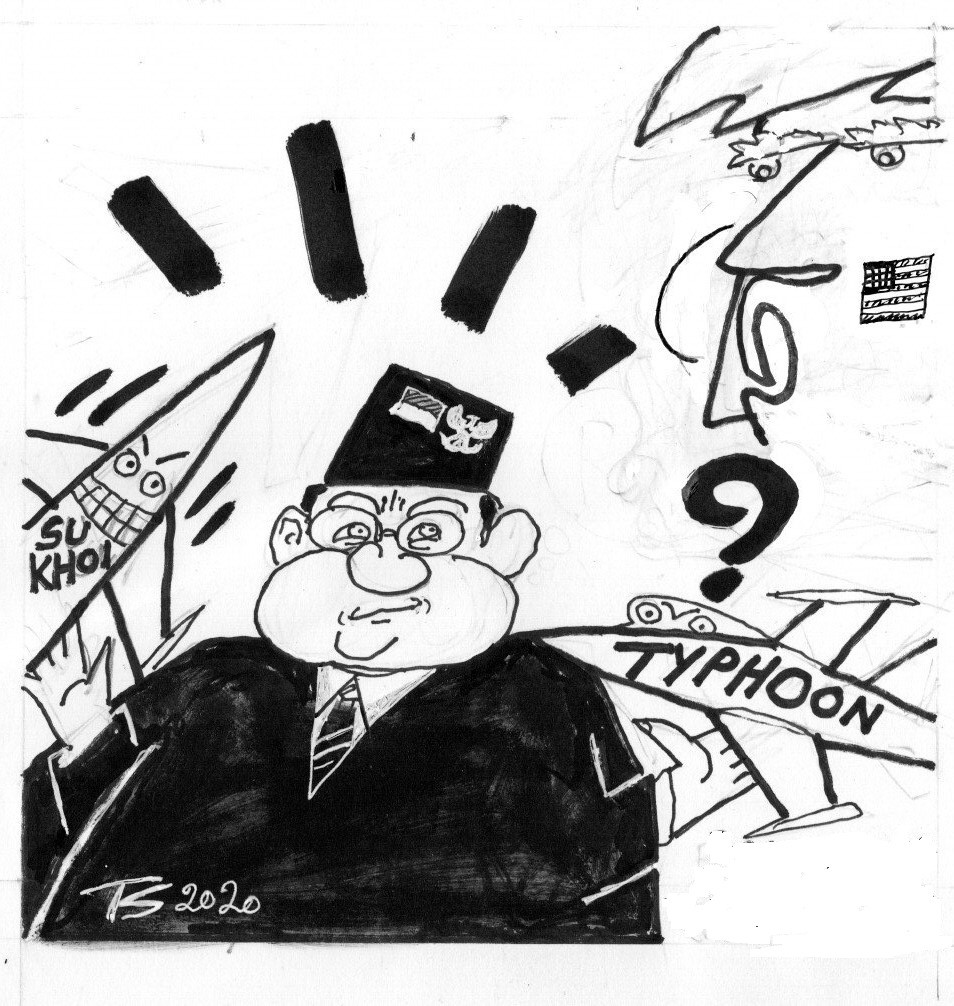Popular Reads
Top Results
Can't find what you're looking for?
View all search resultsPopular Reads
Top Results
Can't find what you're looking for?
View all search resultsChecklist before buying used Eurofighter Typhoons
Prabowo is keen on purchasing the Typhoons to avoid sanctions under the Countering America’s Adversaries Through Sanctions Act (CAATSA).
Change text size
Gift Premium Articles
to Anyone
D
efense Minister Prabowo Subianto has offered to buy 15 used Eurofighter Typhoon jets from the Austrian Air Force. The bid came after the US State Department issued an initial clearance for Indonesia to purchase the Bell-Boeing MV-22 Osprey tiltrotor aircraft.
The plan to buy the Typhoons is not new. In 2015, when the current Indonesian Military (TNI) chief, Air Chief Marshall Hadi Tjahjanto, was the presidential military secretary, the Typhoon was one of the options to strengthen the Air Force fleet. But eventually the government chose to buy Russia’s Sukhoi Su-35, the contract of which was signed on Feb. 14, 2018.
This Typhoon shopping can be interpreted in three ways. First, Prabowo is keen on purchasing the Typhoons to avoid sanctions under the Countering America’s Adversaries Through Sanctions Act (CAATSA). Indonesia risks being penalized if it proceeds with the purchase of 11 Sukhoi Su-35 jet fighters. Indonesia once experienced such kind of punishment, which impacted supplies of spare parts for its Army helicopters.
Second, the arrival of the Typhoons may serve as a stop gap in developing the country’s primary weapons system, as delivery time of used military jets is quicker than that of new ones. New aircraft is normally delivered about four years after a contract is signed.
Lastly, the plan to buy the Typhoons can be seen as defiance to President Joko “Jokowi” Widodo’s order on July 7 for the Defense Ministry to prioritize its defense spending on domestic products in order to boost the economy.
Those interpretations have arisen because the government has not provided adequate information and an explanation on how our defense capabilities will be developed in the next five years. Since taking office last October, Prabowo has yet to release defense strategy policy documents, such as defense white paper, defense strategy, etc. Those documents are essential to understand how the defense sector will be managed until 2024.
The classic problem of lack of transparency over military procurement remains unaddressed, with the shopping list and contacts of military procurements never made available to the public. Therefore, we do not know whether a procurement program, including the purchase of Typhoons, is based on strategic planning or simply an ad-hoc policy.
In this regard, the government should disclose more detailed information about the Typhoon procurement plan. Not only should it unveil the price quote, it should also explain how it will comply with Article 34 of Law No. 16/2012 on the defense industry, especially regarding the transfer of technology, offsets and the mandatory local content of 85 percent. The House of Representatives should also exercise its oversight role to minimize potential misuse of the budget to buy the used jet fighters.
Nevertheless, there are several matters the government should highlight before realizing the shopping of used jets.
First is the issue of main equipment and weapon maintenance. Last June, an Indonesian Air Force Hawk 209 jet crashed in Kampar, Riau. Less than two weeks earlier, an Army Mi-17 helicopter fell in Kendal, Central Java, killing four personnel on board and injuring five others. The two incidents shed light of the unsolved problem, namely maintenance of our defense equipment.
According to Tempo magazine, at least 24 military aircraft were involved in accidents from 2004 to 2020. They do not include TNI helicopters and planes that cannot fly due to shortage of spare parts.
Although the government has consistently increased defense spending in the last few years, it does not fix the problem of maintenance. The annual budget only can cover around 50 to 70 percent of the total maintenance cost. Consequently, the performance of our primary weapons is far from optimum.
Second, there is a need for upskilling our pilots and mechanics. Acquisition of a new type of aircraft requires a specific skill set that our military pilots and technicians have to master. So, regular upgrading of skills is needed to ensure the equipment can operate effectively.
Third, there is an underlying problem in the diversification of military equipment. Indeed, diversification of weapons will help the TNI avoid dependence on a single arms-producing country. But different equipment requires different technicians and treatment. The more diversified our weapons, the higher the maintenance budget.
In addition, the management of the maintenance budget is similar to the general purchase of arms. The government’s fiscal management does not distinguish procurement of military equipment from its maintenance. Thus, in many cases the system cannot accommodate an urgent need of military vehicle and equipment repair.
Because maintenance work of military equipment can be planned or unplanned, a special mechanism is needed. Performance-based logistics may be one of the options the government may consider in order to improve the system.
In this regard, if the government insists on buying the second-hand Typhoons, it should carefully anticipate the maintenance cost of the jets, which may reach a whopping $5 billion. A well-prepared scenario of maintenance is required before acquiring the Typhoons, otherwise they may have to be relocated to the Satria Mandala military museum on Jl. Gatot Soebroto, South Jakarta, in the next few years as new display items.
***
The writer is head of the Center for Intermestic and Diplomatic Engagement (CIDE), Paramadina Graduate School of Diplomacy, Paramadina University, Jakarta










